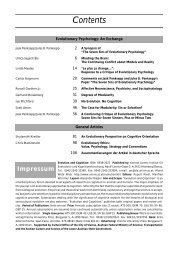Contents - Konrad Lorenz Institute
Contents - Konrad Lorenz Institute
Contents - Konrad Lorenz Institute
You also want an ePaper? Increase the reach of your titles
YUMPU automatically turns print PDFs into web optimized ePapers that Google loves.
An Evolutionary Model of the Effects of Human Paternal Resemblance on Paternal Investment<br />
risk for sperm competition by the female, otherwise<br />
the male might be led to abuse, even infanticide, to<br />
ensure that his resources were not spent on other<br />
male’s offspring. Again, this is counter to the argument<br />
put forth by BRESSAN and colleagues in which<br />
they suggest that males would experience increased<br />
fitness returns by not knowing paternity. This would<br />
only be the case for those males chosen as EPC partners.<br />
One could hypothesize that there is something<br />
about males who engage in EPCs, who are selected as<br />
EPC partners, or who adopt a primarily EPC-driven<br />
reproductive strategy to produce anonymous looking<br />
children. However, because the rates of EPP are<br />
on the order of 1–20%, the majority of males in the<br />
population would still require a means by which to<br />
make assessment about paternity. It therefore is probably<br />
more parsimonious to presume that females<br />
choose EPC partners along two dimensions that help<br />
to ensure investment from their in-pair partner. First,<br />
females could choose to engage in EPCs with males<br />
who resemble their in-pair mate, which would increase<br />
the likelihood that the child might also bear<br />
some resemblance to the in-pair mate. This would<br />
also aid in maternal warping of the social mirror effect<br />
(Gaulin, in press); i.e., if a female chooses an EPC<br />
partner who resembles her in-pair partner, the in-pair<br />
partner may be more susceptible to social affirmations<br />
of resemblance. Second, because females usually<br />
choose EPC partners that are more attractive,<br />
symmetrical, and are presumed to have “better<br />
genes” (see BAKER/BELLIS 1995, for a review), an inpair<br />
mate might be more inclined to react favorably<br />
towards a child that expresses “good genes” (e.g., being<br />
more symmetrical). MEALEY (2003) recently demonstrated<br />
that symmetry among twins did not account<br />
for variation in treatment of the twins.<br />
However, PLATEK et al. (in preparation), using a morphing<br />
paradigm have documented significant differences<br />
in reactions to children’s faces as a function of<br />
symmetry, with more symmetrical faces eliciting<br />
greater positive investment responses. Although the<br />
effects of symmetry may play an important role in<br />
child investment strategies, symmetry is not modeled<br />
here.<br />
Evidence for the Effects of Genetic<br />
Relatedness and Paternal Resemblance<br />
There is evidence that males differentially invest in<br />
children to whom they are genetically related. It is<br />
not uncommon for unrelated, or otherwise stepchildren<br />
to be treated significantly worse than biological<br />
children (e.g., ANDERSON et al. 1999). BURCH and<br />
GALLUP (2000) have shown that the less a male<br />
thinks a child looks like him, the worse he treats the<br />
child, and the worse the relationship with that child<br />
is. DALY and WILSON (1983; DALY/WILSON/WEG-<br />
HORST 1982) have shown that male sexual jealousy<br />
can become violent and can be interpreted as a<br />
byproduct of the fear of infidelity, or possibility of<br />
becoming a cuckold. They estimate the incidence of<br />
abuse that results in infanticide among step-children<br />
to be 100 times that of genetically related children.<br />
These data suggest a strong link between perceived<br />
resemblance, relatedness and the treatment<br />
of children.<br />
However, in terms of assessing resemblance, the<br />
absence of mirrors during human evolution might<br />
have precluded males from being able to objectively<br />
determine the degree of facial resemblance. There<br />
are several hypotheses about how and whether resemblance<br />
could have had effects during our evolutionary<br />
history. The first falls under a category that<br />
has been referred to as the social mirror effect<br />
(BURCH/GALLUP 2000). A social mirror consists of 1)<br />
other people telling you that a child resembles you,<br />
2) making comparisons between your child and<br />
your putative genetic kin, and 3) monitoring behavioral<br />
similarities, or lack thereof, between your offspring,<br />
your kin, and yourself. There are data to support<br />
the existence of a social mirror. It has been<br />
shown that other’s perceptions of offspring-paternal<br />
resemblance is important in 1) the father’s perceptions<br />
of resemblance (DALY/WILSON 1983; REGAL-<br />
SKI/GAULIN 1993) and 2) the degree of violent<br />
behavior enacted by the father toward the offspring<br />
and the mate (BURCH/GALLUP 2000, in press). Further,<br />
DEBRUINE (2002) has shown that people trust<br />
those who resemble them more than those who do<br />
not, suggesting a role for kin-resemblance comparisons<br />
(see also PLATEK et al. 2003).<br />
However, although social mirror information<br />
seems to be important for the ways in which a male<br />
behaves toward a child, my colleagues and I have recently<br />
found that, in hypothetical investment situations,<br />
males react more positively toward faces of<br />
children that actually share more of their own facial<br />
features (PLATEK et al. 2002). This morphing study<br />
employed stimulus faces that represented a 50%<br />
morph; i.e., the stimulus child’s face was 50% child<br />
and 50% subject. We have found that, in order for a<br />
male to change from reacting indifferently to favorably<br />
toward a child’s face they must share at least<br />
25% facial characteristics in common with the<br />
child’s face (PLATEK et al. 2003). This proportion of<br />
shared characteristics parallels the degree of shared<br />
Evolution and Cognition ❘ 191 ❘ 2003, Vol. 9, No. 2








